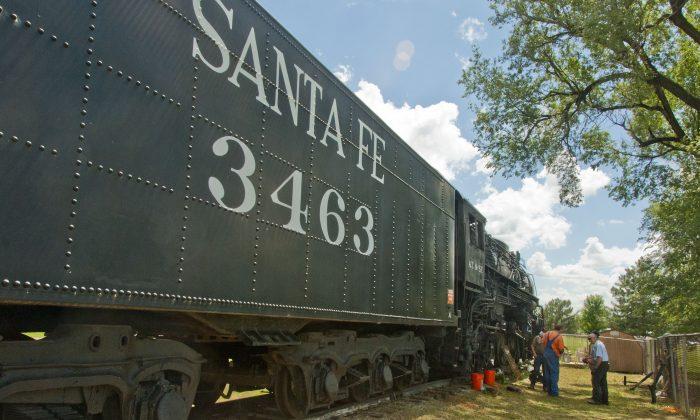American steam trains are waging a comeback, and it’s more than a romantic nod to the past. Since 2011, the Coalition for Sustainable Rail (CSR) has been working to develop a passenger train that is cleaner, more powerful, and less expensive than the competition.
With the nonprofit Sustainable Rail International (SRI) and the University of Minnesota collaborating, CSR will prove its claim with a locomotive that hasn’t run since 1957. With a few modifications, engineers say the retired train will soon reach speeds of more than 130 mph, and leave behind a minimal carbon footprint.
Steam Versus Diesel
Beginning in the 1820s, American industry and travel chugged along by virtue of steam power. But after World War II, U.S. rail changed course.
In the 1950s, diesel was cheap, and steam locomotive manufacturers—each with custom designs and no interchangeability—couldn’t match the General Motors production model, which could reliably churn out the same engines for trains that were previously made for submarines.
Fast-forward to today’s push for high-speed passenger trains, and the diesel advantage starts to fizzle. According to SRI President Davidson Ward, diesel trains exhibit great horsepower up to about 40 to 50 mph, but once the circuit hits higher speeds, performance peters out.
“What Amtrak has discovered with their new Chicago to St. Louis high speed rail project which opened in the past couple years is that they need two locomotives to haul their six car passenger trains to 110 mph with the necessary acceleration. One locomotive can’t accelerate that train fast enough to make it economically viable,” Ward said.
Steam power, however, excels at higher speeds. By the 1930s, steam locomotives ran at over 100 mph daily just to stay on schedule. And unlike electric trains, steam engines can use the same Amtrak lines.
For advances in steam technology, SRI looks to Argentina—a country that embraced steam power just as America abandoned it. In the 1950s, mechanical engineer Livio Dante Porta took emerging thermodynamic ideas and applied them to steam power, modernizing trains across South America and around the world until his death in 2003.
Porta’s innovations solved problems of complex parts, tedious upkeep, and other issues associated with the steam power of yesteryear. According to Ward, maintenance costs have been reduced by 90 percent.
“That’s a big deal in terms of making these things more competitive down the road,” he said.
Inspired by the prospect of importing Porta’s ideas to the United States, Ward joined forces with Porta protégé Shaun McMahon, and steam locomotive experts Rob Mangles and John Rhodes. The SRI team was familiar with steam power’s muscle and versatility, but they also needed to tackle remnants of its polluting past.
“In all these propaganda posters from the 1930s from the WPA you had smokestacks belching clouds of smoke. At the time that was a sign of progress and prosperity. Obviously, that’s not how we see things now,” said Ward.
Porta had already improved combustion efficiency so that smoke no longer billowed from the stack. But in order to sell the idea in America, SRI needed an economically viable fuel cleaner than coal.
The answer came from researchers at the University of Minnesota (U of M) who developed torrefied biomass—a fuel made of plant material that has been roasted, condensed, and pressed into easy-to-use pucks. This “biocoal” has all the attributes of regular coal, but is twice as thermally efficient and has none of the heavy metals, sulfur, or other noxious emissions that coal does.
Biocoal is mostly made from wood—abundant in northern Minnesota since the housing bust—but the torrefaction process has also been applied to pest plants. U of M researchers recently returned from Mauritania where they produced biocoal from a local invasive cattail.
Old Train, New Life
In order to showcase their innovations of fuel and engineering, CSR purchased a 1937-built Super Hudson, known as the Topeka & Santa Fe No. 3463. The engine has been out of service for over 50 years, but ran 1.3 million miles in its day, at a speed of more than 90 mph.
Repairs began in June, and the old train shows its age. Paint is peeling, all the stay bolts have rusted through; but Ward says the integral pieces—wheels, frame, cylinders, and boiler—still have lots of life left in them.
Recycling an old train follows CSR’s green outlook, but the choice has other practical benefits as well. Ward said that even with the price of the old engine plus restoration and modification costs, using No. 3436 as a test platform is about five times cheaper than actually building something from scratch.
When the transformation is complete, engineers are confident the old train will break the world steam record of 130 mph, but Ward said there is room for improvement. In the spirit of Porta, CSR will continue tinkering with the design.
“Down the road we’re looking at not even ejecting steam out of the smoke stack. We’re looking at turning that steam back into water. And that’s where you really start to see some gains in efficiency,” Ward said.





